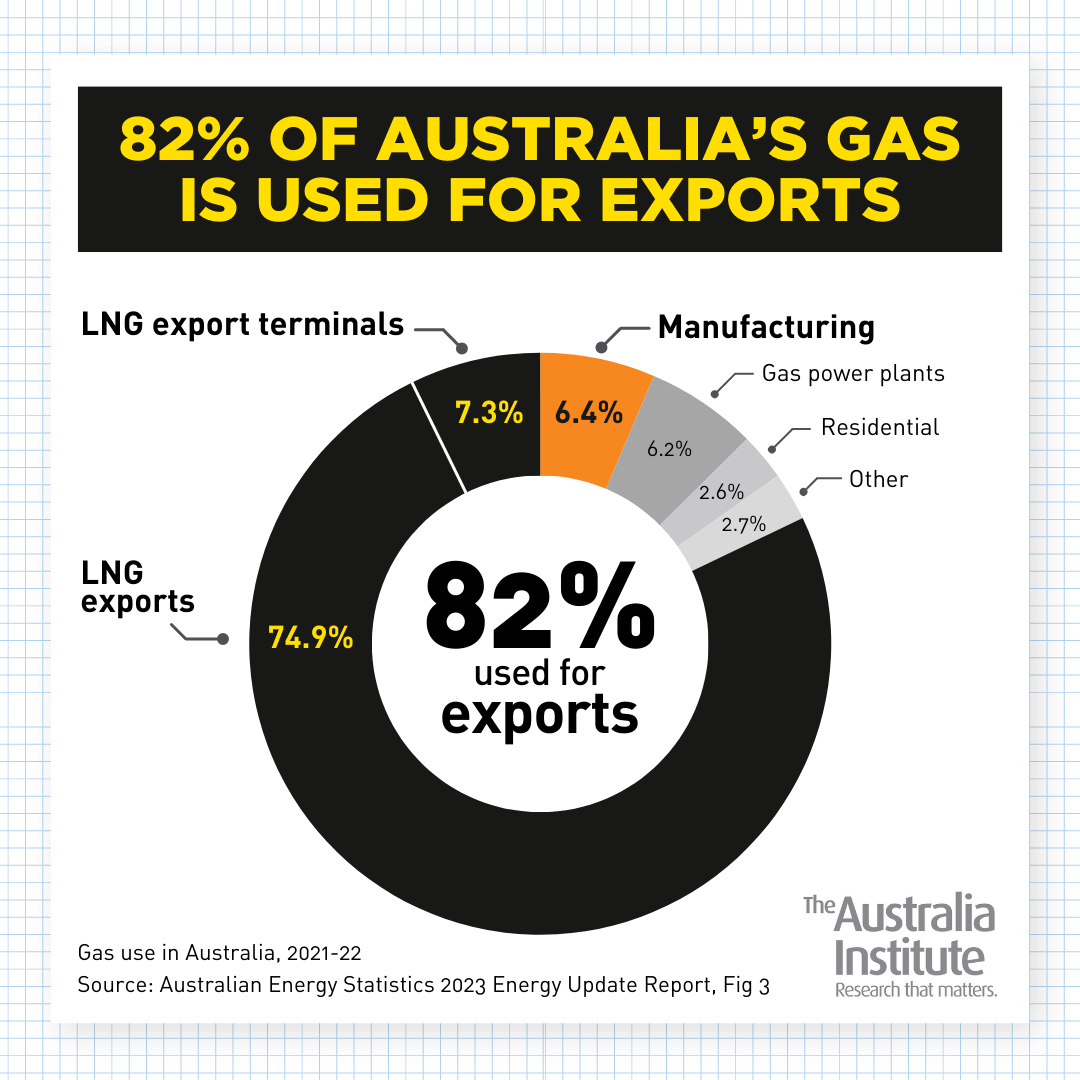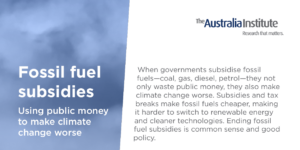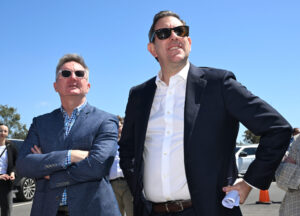6 gas facts to help you cut through fossil fuel spin

There’s a lot of misinformation in the debate surrounding Australia’s gas industry. To be clear: the world cannot afford for new gas projects (or any other fossil fuel projects) to be opened if we want to avoid dangerous climate change.
The Future Gas Strategy (the Government’s plan to expand fossil gas until 2050), the Minister for Climate Change and Energy’s defence of the “critical role” of the gas industry, and the Government’s $1.5 billion commitment for the Middle Arm “sustainable development” (actually a gas manufacturing hub) are completely contrary to the scientific reality, and make clear that the Government’s priorities lie with the gas industry, not with its climate commitments.
In this critical decade when fossil fuel use should be plummeting, Australian governments are investing in expanding the gas industry and telling us it’s both good for the climate and the economy.
It’s not. Here’s why expanding the gas industry is economically and environmentally reckless.
1. Gas is a small employer
While the gas industry would have you think it’s a huge employer in Australia, in reality, gas doesn’t create very many jobs.
Australia Institute research shows that for every million dollars it makes in sales, the gas industry creates just 0.2 jobs, while industries like education and training (private) create 9.3 jobs.
In total, across the country, gas and oil extraction employs just 21,200 workers – less than half of one percent (0.15%) of the 14 million people employed in Australia. If the Government wanted to create jobs, its investment would be better spent in almost any other industry than the oil and gas industry.

2. Australia collects more money from HECS than the Petroleum Resource Rent Tax (PRRT)
The PRRT is one of the main ways the Federal Government collects revenue from the gas industry.
The Australian Government collects twice as much money from HECS repayments than from the PRRT.
In 2022-23, the Government raised just $2.3 billion from the PRRT (it collected $4.9 billion in student loan repayments).
"The Australian Government collects more money from HECS than it does from the Petroleum Resource Rent Tax.
"Thank you, children. You're the backbone of our economy, not the gas industry."
Executive Director Richard Denniss at @PressClubAust@RDNS_TAI #auspol pic.twitter.com/osD3SWF4wF
— Australia Institute (@TheAusInstitute) January 31, 2024
Mayors and community leaders from across Australia have called for an additional $10 billion to be collected via the PRRT to secure funding for local governments to cope with the impacts of climate change. Australia Institute research shows that simple reforms to the PRRT could raise $18 billion over the next four years. Yet the Federal Government’s Future Gas Strategy has precisely zero mentions of the Petroleum Resource Rent Tax.
Add your name to calls to increase the PRRT.
Even in the major gas-producing states like Western Australia and the Northern Territory, gas represents less than 1.5% of budget revenue. Very few royalties are paid on Australia’s offshore gas projects. In Western Australia, drivers pay more in vehicle registration than the gas industry pays in royalties.
3. Around 80% of Australia’s gas is used for exports
When the gas industry tells you Australia needs to open new gas to prop up the manufacturing industry, it fails to mention that 80% of Australia’s gas is used for exports. Australia exports over 10 times more gas than is used by Australia’s entire manufacturing industry. In fact, the Australian manufacturing industry could increase its gas use by 10% and still use less than is required by the gas industry to convert gas into LNG for export. You read that right: the gas industry uses gas to make liquefied gas so it can export gas – and the liquefaction step alone uses more gas than is used by Australia’s manufacturing industry.

4. Australia’s national security does not rely on more gas exports
The narrative that Australian gas exports support regional security and stability incorrectly conflates fossil fuels, trade relationships, energy security and regional stability, asserting that Australia must continue to export gas in order to avoid trade disputes and maintain Australia’s national security.
But Australia frequently has trade disputes with its partners. In October, for example, the Australian government abruptly and unilaterally withdrew from Free Trade Agreement negotiations with the European Union. There is no suggestion that this dispute will impact Australia’s national security.
In the Future Gas Strategy, the focus is on “Australia” as a reliable international supplier. But LNG exports involve a very small number of multinational companies exporting gas. This narrative confuses the commercial interests of those companies with the Australian national interest.
Dr Emma Shortis explains how the claim that supporting the gas industry is about ‘national security’ is both wrong and dangerous:
5. Gas will make the climate crisis worse for the Pacific
Climate change, accelerated by Australia’s continued supply of fossil fuels, poses a serious, direct and immediate threat to human and environmental security. In the Pacific, rising sea levels caused by climate change threaten to inundate entire nations.
In Tuvalu, for example, sea level has already risen 15cm in the last 30 years (the highest point in the country is less than 5 metres above sea level), and flooding from king tides made worse by climate change reached 3.4 metres in April 2024.
But rather than take meaningful action on climate change, Australia has instead invested in a climate mobility deal to assist people from Tuvalu to migrate to Australia because “we believe the people of Tuvalu deserve the choice to live, study and work elsewhere, as climate change impacts worsen”. On the same day as it announced the Future Gas Strategy which locks in fossil fuel expansion until 2050, the Australian Government announced $38 million in support for the Tuvalu Coastal Adaptation Project.
That is, the Australian Government is planning for new gas, completely aware of the existential threat that climate change poses to Tuvalu, and is throwing minuscule resources (compared with $11.8 billion in fossil fuel subsidies over the last financial year) to Tuvaluans instead of taking meaningful action to phase out fossil fuels and protect the Pacific from the worst impacts of climate change.
Referring to the climate mobility deal, Rt Hon Enele S Sopoaga PC, Former Prime Minister of Tuvalu, said at the Australia Institute’s 2024 Climate Integrity Summit that he has “never seen anything so brazen, so disrespectful, as this agreement”.
6. Gas is a fossil fuel, not a transition fuel
Burning gas creates greenhouse gas emissions. Extracting gas creates greenhouse gas emissions. That means it’s not a transition fuel.
Global warming is already at 1.1C. There is no room in the global carbon budget to approve new gas mines. Yet the Future Gas Strategy locks Australia in for decades of more fossil fuel expansion. This is not a transition plan.
Limiting global warming to 1.5C requires rapid decarbonisation and the prevention of all new fossil fuel projects – including gas – in favour of truly zero-emissions energy.
Conclusion
It’s clear that Australia’s gas policies are grounded in the interests of fossil fuels, not decarbonisation.
To truly prioritise rapid emissions reduction in line with calls by the IEA, the United Nations, the UNFCCC and scientists in Australia and around the world, there is no room for gas in the transition to zero-emissions renewable energy.
The fossil fuel industry isn’t paying its fair share, and currently, the government is considering reforms to the PRRT.
Add your name to the call to increase the PRRT and raise billions of dollars in revenue that can be spent on dealing with the costs and impacts of the climate crisis, driven by Australia’s massive fossil gas export industry.
Between the Lines Newsletter
The biggest stories and the best analysis from the team at the Australia Institute, delivered to your inbox every fortnight.
You might also like
Fossil fuel subsidies
When governments subsidise fossil fuels—coal, gas, diesel, petrol—they not only waste public money, they also make climate change worse. Subsidies and tax breaks make fossil fuels cheaper, making it harder to switch to renewable energy and cleaner technologies. Ending fossil fuel subsidies is common sense and good policy.
Why a fossil fuel-free COP could put Australia’s bid over the edge
When the medical world hosts a conference on quitting smoking, they don’t invite Phillip Morris, or British American Tobacco along to help “be part of the solution”.
The great gas rip off: how the government can stop us all getting burned
The Albanese government could soon intervene to start fixing one of the biggest ongoing public policy fiascos in this country’s history: Australia’s rampant, uncontrolled gas export industry.




